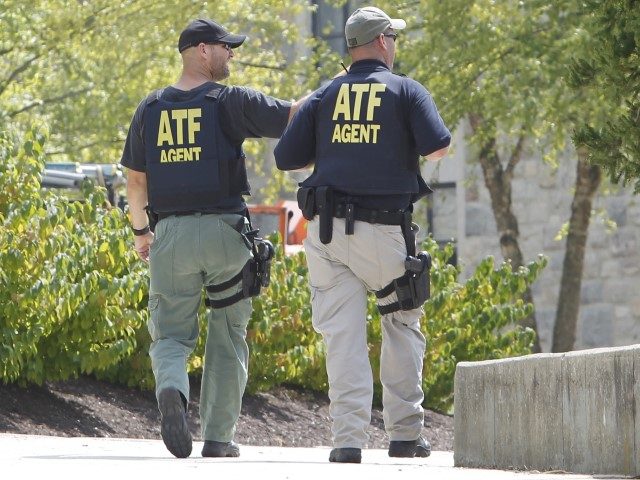The Bureau of Alcohol, Tobacco, Firearms, and Explosives (ATF) announced the finalization of its stabilizer brace ban on Friday, and within hours, members of Congress were talking about using the Congressional Review Act (CRA) to block it.
The CRA was put in place in the 1990s as part of Speaker Newt Gingrinch’s (R) “Contract with America.” It grants Congress the ability to review a major rule and vote to block the implementation or effectiveness of the rule.
The Brookings Institute summarizes the CRA:
Passed as part of the Contract with America Advancement Act of 1996, the Congressional Review Act creates a streamlined procedure by which Congress can disapprove and thereby nullify regulations promulgated by various federal government agencies. The CRA requires that all rules be reported to Congress. Upon receiving that report, Congress then has 60 legislative working days (which is generally a much longer period than 60 calendar days) to introduce a special joint resolution of disapproval of the rule.
That resolution can be discharged from committee and can avoid the Senate’s filibuster, thereby empowering Congress to contend with the administrative state’s vast rulemaking powers on something closer to an equal footing.
The U.S. Government Accountability Office explains the CRA thusly: “The CRA allows Congress to review ‘major’ rules issued by federal agencies before the rules take effect. Congress may also disapprove new rules, resulting in the rules having no force or effect.”
One of the characteristics that allows a rule to be considered “major” is if it carries $100 million or more in annual cost. In announcing the passage of their final stabilizer brace rule, the ATF points out, “This rule is projected to have an effect of over $100 million on the economy in at least one year of the final rule.”
On January 13, 2023, Breitbart News reported the ATF’s final rule announcement, noting that it gives current owners of AR pistol stabilizer braces 120 days to do one of the following:
• Scenario 1: Turn in the entire firearm with the attached “stabilizing brace” to ATF;
• Scenario 2: Destroy the whole firearm;
• Scenario 3: Convert the short-barreled rifle into a long-barreled rifle;
• Scenario 4: Apply to register the weapon under the NFA; or
• Scenario 5: Permanently remove and dispose of, or alter, the “stabilizing brace” from the firearm such that it cannot be reattached.
The ATF observes:
This rule is effective the date it is published in the Federal Register. Any weapons with “stabilizing braces” or similar attachments that constitute rifles under the NFA must be registered no later than 120 days after date of publication in the Federal Register; or the short barrel removed and a 16-inch or longer rifle barrel attached to the firearm; or permanently remove and dispose of, or alter, the “stabilizing brace” such that it cannot be reattached; or the firearm is turned in to your local ATF office. Or the firearm is destroyed.
In July 2021, when the pistol brace rule was at the proposal stage, Rep. Richard Hudson (R) led 140 members of Congress in suggesting the proposed rule was a tax on “disabled combat veterans.”
Hudson called for the stabilizer brace proposal to be withdrawn, noting that the ATF had many times explained its position that such braces were “legitimate”:
The ATF has repeatedly stated, “the brace concept was inspired by the needs of disabled combat veterans who still enjoy recreational shooting but could not reliably control heavy pistols without assistance. Consequently, ATF agrees that there are legitimate uses for certain ‘stabilizing braces.’” If this is the stance of the ATF, then…[the proposed AR-pistol rule] is not an attempt to curb gun violence as suggested by this proposed guidance, but a direct tax on disabled combat veterans.
On July 16, 2021, the Republicans in the House Judiciary Committee reacted to the ATF’s stabilizer brace rule proposal: “The ATF’s proposed rule goes well beyond the authority granted to the agency in any applicable federal statutes. Congress has not criminalized the use of a pistol arm-stabilizing brace under the GCA or allowed for its regulation under the NFA. Through its proposed rule, ATF seeks to subject stabilizing braces to GCA criminal penalties and NFA regulation without Congressional prohibition of the underlying activity.”
The Congressional Review Act is in place for moments such as this and is apropos if, in fact, the stabilizer brace ban meets all the criteria of a “major” rule.
The U.S. Government Accountability Office explains: “The CRA allows Congress to review ‘major’ rules issued by federal agencies before the rules take effect. Congress may also disapprove new rules, resulting in the rules having no force or effect.”
AWR Hawkins is an award-winning Second Amendment columnist for Breitbart News and the writer/curator of Down Range with AWR Hawkins, a weekly newsletter focused on all things Second Amendment, also for Breitbart News. He is the political analyst for Armed American Radio and a Turning Point USA Ambassador. AWR Hawkins holds a PhD in Military History, with a focus on the Vietnam War (brown water navy), U.S. Navy since Inception, the Civil War, and Early Modern Europe. Follow him on Instagram: @awr_hawkins. You can sign up to get Down Range at breitbart.com/downrange. Reach him directly at awrhawkins@breitbart.com.

COMMENTS
Please let us know if you're having issues with commenting.